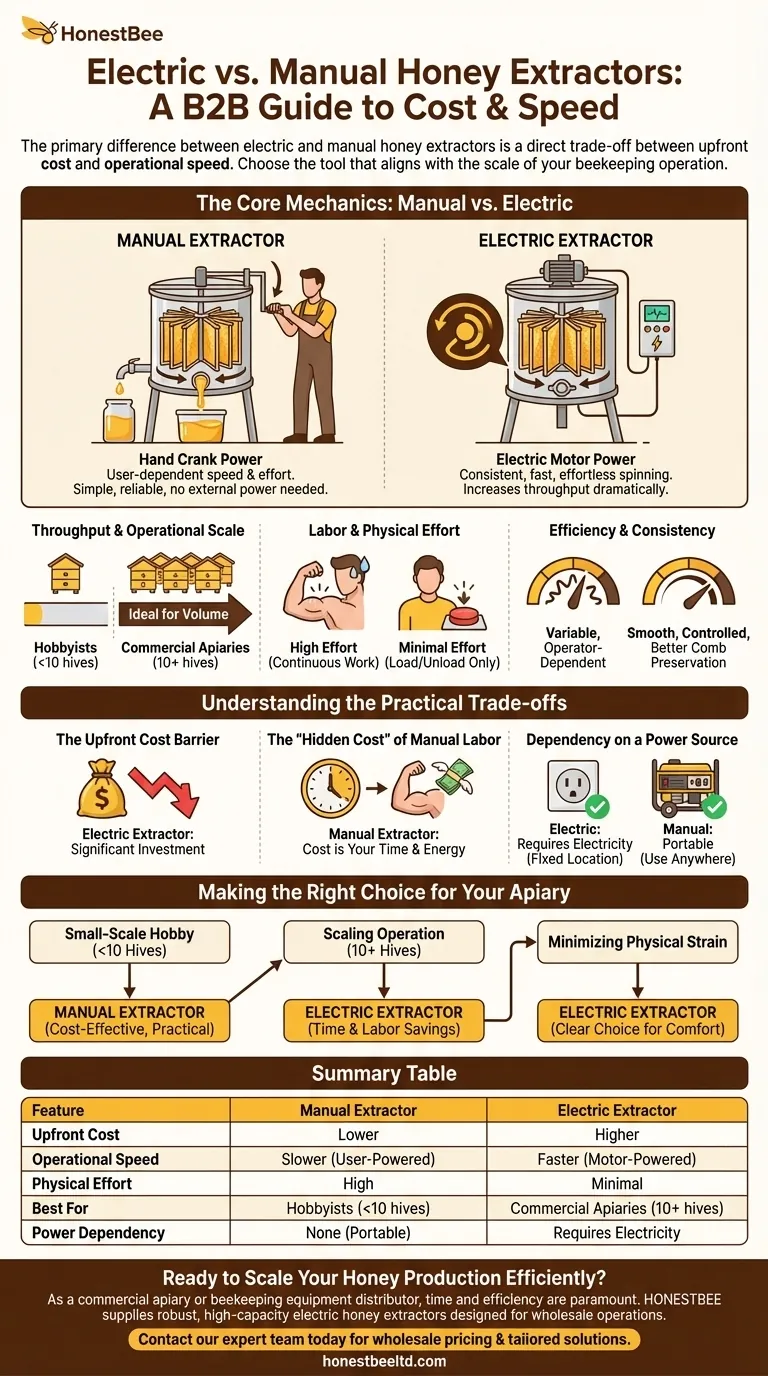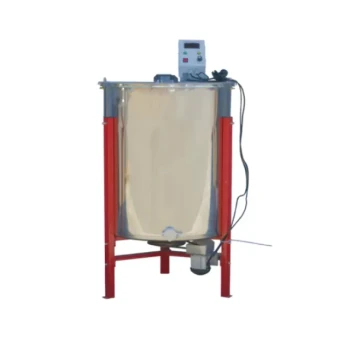The primary difference between electric and manual honey extractors is a direct trade-off between upfront cost and operational speed. Electric models are significantly faster and require minimal physical effort, but come with a higher price tag. Manual extractors are far more affordable, making them an accessible entry point, but they demand considerable time and physical labor to operate.
The decision is not about which extractor is inherently "better," but about which tool is appropriate for the scale of your beekeeping operation. The number of hives you manage and the value you place on your time are the most critical factors in this choice.

The Core Mechanics: Manual vs. Electric
The fundamental difference in cost and speed comes from the power source used to spin the frames and extract the honey via centrifugal force.
The Manual Extractor
A manual extractor is powered by a hand crank. The operator must physically turn the crank to generate the spinning motion needed to pull honey from the combs.
This direct physical involvement means the process is entirely dependent on your stamina. It offers a simple, reliable mechanism with no need for an external power source.
The Electric Extractor
An electric extractor replaces the hand crank with an electric motor. With the press of a button or the turn of a dial, the motor spins the frames at a consistent and often programmable speed.
This automation makes the process faster and virtually effortless for the operator, dramatically increasing the number of frames that can be processed in a given time.
A Deeper Comparison: Beyond Just Cost and Speed
While cost and speed are the headline differences, the right choice depends on a more nuanced understanding of efficiency, labor, and scale.
Throughput and Operational Scale
Electric extractors are built for volume. Their speed and efficiency make them ideal for beekeepers with a large number of hives, often defined as ten or more.
Manual extractors are best suited for hobbyists with just a few hives. The time commitment is manageable when you are only processing a small number of frames.
Labor and Physical Effort
This is a critical, non-negotiable factor. Operating a manual extractor is physically demanding work that requires continuous effort.
Electric models almost eliminate this physical strain, reducing the extraction process to loading and unloading frames. This is a major advantage for larger operations or for beekeepers who wish to avoid heavy physical labor.
Efficiency and Consistency
Electric motors provide a smooth, consistent spin. This controlled force can lead to a more efficient extraction and helps preserve the delicate wax comb for the bees to reuse.
Manual cranking can be less consistent, with speeds varying based on operator fatigue. This can sometimes result in less honey being extracted or a higher risk of damaging combs.
Understanding the Practical Trade-offs
Choosing an extractor requires acknowledging the downsides and limitations of each option. Objectivity is key to making a sound investment.
The Upfront Cost Barrier
The primary drawback of an electric extractor is its significant upfront cost. For a small-scale beekeeper, this expense can be difficult to justify.
The "Hidden Cost" of Manual Labor
While a manual extractor is cheaper to purchase, its true cost includes your time and physical energy. What you save in dollars, you spend in effort.
Dependency on a Power Source
An electric extractor is useless without electricity. This can be a major limitation if your honey house or extraction area is off-grid or in a remote location.
A manual extractor, by contrast, offers complete portability and can be used anywhere.
Making the Right Choice for Your Apiary
Your decision should be a direct reflection of your specific beekeeping goals, budget, and physical capacity.
- If your primary focus is a small-scale hobby (fewer than 10 hives): A manual extractor offers the most cost-effective and practical solution for your needs.
- If your primary focus is scaling your operation (10+ hives): An electric extractor is a necessary investment that will save you immense amounts of time and labor.
- If your primary focus is minimizing physical strain: The automation of an electric extractor makes it the clear choice, regardless of your hive count.
Ultimately, the right extractor is the one that aligns with the scale of your ambition and the resources you are willing to invest.
Summary Table:
| Feature | Manual Extractor | Electric Extractor |
|---|---|---|
| Upfront Cost | Lower | Higher |
| Operational Speed | Slower (User-Powered) | Faster (Motor-Powered) |
| Physical Effort | High | Minimal |
| Best For | Hobbyists (<10 hives) | Commercial Apiaries (10+ hives) |
| Power Dependency | None (Portable) | Requires Electricity |
Ready to Scale Your Honey Production Efficiently?
As a commercial apiary or beekeeping equipment distributor, your time and efficiency are paramount. HONESTBEE supplies robust, high-capacity electric honey extractors designed for wholesale operations, significantly reducing labor costs and increasing your throughput.
Let us help you select the perfect extraction equipment to match your scale and boost your profitability. Contact our expert team today for wholesale pricing and tailored solutions.
Visual Guide

Related Products
- HONESTBEE 72 Frame Industrial Electric Honey Extractor for Beekeeping
- Professional 4 Frame Self Reversing Electric Honey Extractor for Beekeeping
- HONESTBEE 6 Frame Self Reversing Electric Honey Extractor for Beekeeping
- 8-Frame Electric Self-Reversing Honey Extractor Spinner for Commercial Honey Extraction Equipment
- HONESTBEE 3-Frame Manual Acrylic Honey Extractor
People Also Ask
- What are the two common types of honey extractors? Choose the Right Extractor for Your Apiary
- What should a beekeeper do after extracting honey from supers? A Guide to Harvest Management
- What are the advantages of automatic honey extractors? Scale Your Apiary with Unmatched Efficiency
- Why is preserving honeycomb integrity important, and how do automated extractors help? Boost Hive Health & Honey Yields
- What is the energy consumption like for automatic honey extractors? Maximize Your Harvest Efficiency



















